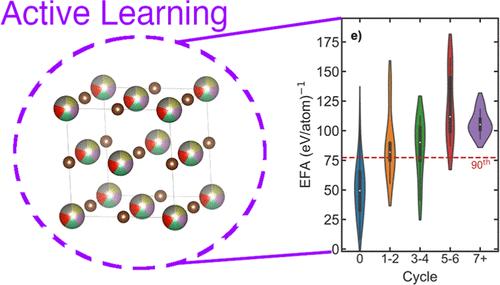当前位置:
X-MOL 学术
›
Chem. Mater.
›
论文详情
Our official English website, www.x-mol.net, welcomes your
feedback! (Note: you will need to create a separate account there.)
Accelerating the Discovery of New, Single Phase High Entropy Ceramics via Active Learning
Chemistry of Materials ( IF 7.2 ) Pub Date : 2024-11-05 , DOI: 10.1021/acs.chemmater.4c00303 Calen J. Leverant, Jacob A. Harvey
Chemistry of Materials ( IF 7.2 ) Pub Date : 2024-11-05 , DOI: 10.1021/acs.chemmater.4c00303 Calen J. Leverant, Jacob A. Harvey

|
High-entropy ceramics have garnered interest due to their remarkable hardness, compressive strength, thermal stability, and fracture toughness; yet the discovery of new high-entropy ceramics (out of a tremendous number of possible elemental permutations) still largely requires costly, inefficient, trial-and-error experimental and computational approaches. The entropy forming ability (EFA) factor was recently proposed as a computational descriptor that positively correlates with the likelihood that a 5-metal high-entropy carbide (HECs) will form the desired single phase, homogeneous solid solution; however, discovery of new compositions is computationally expensive. If you consider 8 candidate metals, the HEC EFA approach uses 49 optimizations for each of the 56 unique 5-metal carbides, requiring a total of 2744 costly density functional theory calculations. Here, we describe an orders-of-magnitude more efficient active learning (AL) approach for identifying novel HECs. To begin, we compared numerous methods for generating composition-based feature vectors (e.g., magpie and mat2vec), deployed an ensemble of machine learning (ML) models to generate an average and distribution of predictions, and then utilized the distribution as an uncertainty. We then deployed an AL approach to extract new training data points where the ensemble of ML models predicted a high EFA value or was uncertain of the prediction. Our approach has the combined benefit of decreasing the amount of training data required to reach acceptable prediction qualities and biases the predictions toward identifying HECs with the desired high EFA values, which are tentatively correlated with the formation of single phase HECs. Using this approach, we increased the number of 5-metal carbides screened from 56 to 15,504, revealing 4 compositions with record-high EFA values that were previously unreported in the literature. Our AL framework is also generalizable and could be modified to rationally predict optimized candidate materials/combinations with a wide range of desired properties (e.g., mechanical stability, thermal conductivity).
中文翻译:

通过主动学习加速发现新的单相高熵陶瓷
高熵陶瓷因其卓越的硬度、抗压强度、热稳定性和断裂韧性而引起了人们的兴趣;然而,发现新的高熵陶瓷(从大量可能的元素排列中)在很大程度上仍然需要昂贵、低效、试错的实验和计算方法。熵形成能力 (EFA) 因子最近被提议作为计算描述符,它与 5 金属高熵碳化物 (HEC) 形成所需单相均相固溶体的可能性呈正相关;但是,发现新组合的计算成本很高。如果考虑 8 种候选金属,HEC EFA 方法对 56 种独特的 5 金属碳化物中的每一种使用 49 次优化,总共需要 2744 次昂贵的密度泛函理论计算。在这里,我们描述了一种用于识别新型 HEC 的更有效的主动学习 (AL) 方法。首先,我们比较了生成基于组合的特征向量的多种方法(例如 magpie 和 mat2vec),部署了一组机器学习 (ML) 模型来生成预测的平均值和分布,然后将分布用作不确定性。然后,我们部署了一种 AL 方法来提取新的训练数据点,其中 ML 模型集成预测了高 EFA 值或不确定预测。我们的方法的综合好处是减少了达到可接受的预测质量所需的训练数据量,并使预测偏向于识别具有所需高 EFA 值的 HEC,这些值与单相 HEC 的形成暂时相关。 使用这种方法,我们将筛选的 5 金属碳化物的数量从 56 种增加到 15,504 种,揭示了 4 种具有创纪录高 EFA 值的成分,这些成分以前在文献中未报道过。我们的 AL 框架也是可推广的,可以对其进行修改,以合理预测具有广泛所需特性(例如机械稳定性、导热性)的优化候选材料/组合。
更新日期:2024-11-07
中文翻译:

通过主动学习加速发现新的单相高熵陶瓷
高熵陶瓷因其卓越的硬度、抗压强度、热稳定性和断裂韧性而引起了人们的兴趣;然而,发现新的高熵陶瓷(从大量可能的元素排列中)在很大程度上仍然需要昂贵、低效、试错的实验和计算方法。熵形成能力 (EFA) 因子最近被提议作为计算描述符,它与 5 金属高熵碳化物 (HEC) 形成所需单相均相固溶体的可能性呈正相关;但是,发现新组合的计算成本很高。如果考虑 8 种候选金属,HEC EFA 方法对 56 种独特的 5 金属碳化物中的每一种使用 49 次优化,总共需要 2744 次昂贵的密度泛函理论计算。在这里,我们描述了一种用于识别新型 HEC 的更有效的主动学习 (AL) 方法。首先,我们比较了生成基于组合的特征向量的多种方法(例如 magpie 和 mat2vec),部署了一组机器学习 (ML) 模型来生成预测的平均值和分布,然后将分布用作不确定性。然后,我们部署了一种 AL 方法来提取新的训练数据点,其中 ML 模型集成预测了高 EFA 值或不确定预测。我们的方法的综合好处是减少了达到可接受的预测质量所需的训练数据量,并使预测偏向于识别具有所需高 EFA 值的 HEC,这些值与单相 HEC 的形成暂时相关。 使用这种方法,我们将筛选的 5 金属碳化物的数量从 56 种增加到 15,504 种,揭示了 4 种具有创纪录高 EFA 值的成分,这些成分以前在文献中未报道过。我们的 AL 框架也是可推广的,可以对其进行修改,以合理预测具有广泛所需特性(例如机械稳定性、导热性)的优化候选材料/组合。


















































 京公网安备 11010802027423号
京公网安备 11010802027423号